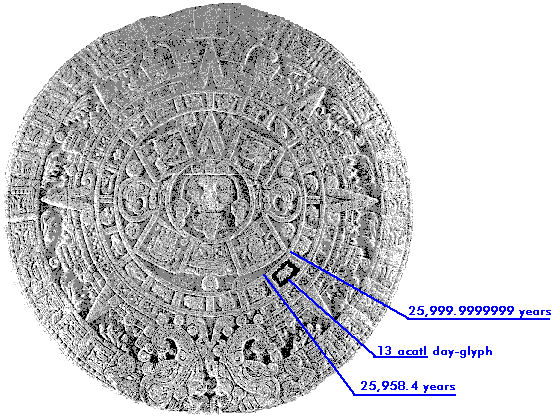THE RING OF FLAMES
 |
Now, consider the difference in value between these two figure:
| 25,999.999999999 | years |
| 25,958.4 | |
| 41.599999999 | years |
It is significant to note that 41.59 is extremely close, and certainly represents the fractal of the 416 yearly cycle identified in the 52:365c reckoning system (Earth/matrix No. 8). The 416-year cycle represents eight 52-year cycles, or four 104-year cycles, which were of such great significance to Mesoamerican reckoning systems. If the Sun's Great Cycle were exactly 26,000 years (as it had once been believed), then there would be exactly five hundred 52-year cycles within that period.
But, given the fact that the Sun slips back one revolution on its axis, then that figure is less and open to discussion. In 25,958.4 years there would be 499.2 52-year cycles. In the maya count of 25,956 years, there would be 499.153846153 52-year cycles. However, the maya figure of 25,956 would not yield a cycle difference of 41.59999999, but rather a difference of 43.9999999. Therefore, one may conclude that the design within the Aztec Calendar possibly reflects in a more exact manner the numerical relationships prevalent in the ancient reckoning system of the 52:365c.
One must realize, however, that even though it is known that the ancient astronomers sought to work with whole cycles and rounded off numbers, they did make adjustments in their calculations. This meant that their knowledge was exact regarding the behavior of the Sun and the planetary bodies within the solar system. That was precisely how they were able to make adjustments in their calculations. Exactly how did they make the adjustments seems to lie within the apparent logic of the numbers and the design portrayed in the distinct reckoning systems.
From the above analysis, it should be apparent that possibly they worked on one level with whole cycles and whole numbers, while encoding the fractions and adjustments at another level, working with relative ease from one level to another, going from one reckoning system to another. The design of the numbers and the physical presentation of the design of spatial allotment, for example, in their artwork such as the Aztec Calendar, might portray this very fact.
Let us remember, however, that the assignment of values and the analysis that we have presented in this essay represents one possible set of calculations for the Ring of Flames. By employing other reckoning systems, other relations may be obtained. This would imply that our interpretation of the possible meaning of the 13 acatl sign on the Aztec Calendar does not necessarily deny the other interpretations that already exist. For as we have seen repeatedly: a single element may enjoy distinct and varied meanings.
This may be exemplified in the following example. In an earlier essay (Earth/matrix No. 8), we saw how Venus' orbit corresponds to a 65-year cycle with a 584 day-count (65:584), which produces a 16250 year cycle (584c) to the Sun's Great Cycle of 26,000 years (365c).
Now, if we assign a value of 1300 years to each day-glyph sign on the day-glyph ring of the Aztec Calendar, then the total of those twenty day-glyph signs would represent 26,000 years.
Further, it would be obvious that thirteen day-glyph signs would then represent 16900 years (13 x 1300 = 16900). And, that 12.5 day-glyph signs would represent exactly the 16250 figure of Venus' corresponding cycle. Twelve-and-an-half day-glyph signs would fall exactly in the middle of the thirteenth sign, acatl.
Part Five